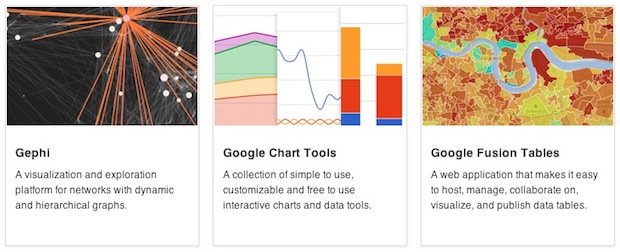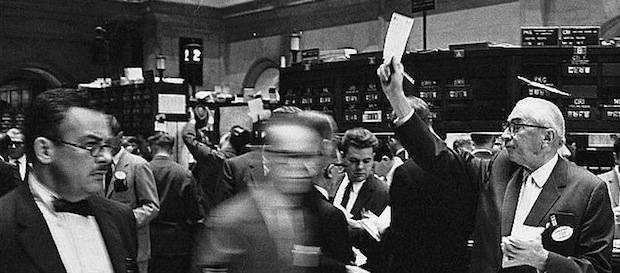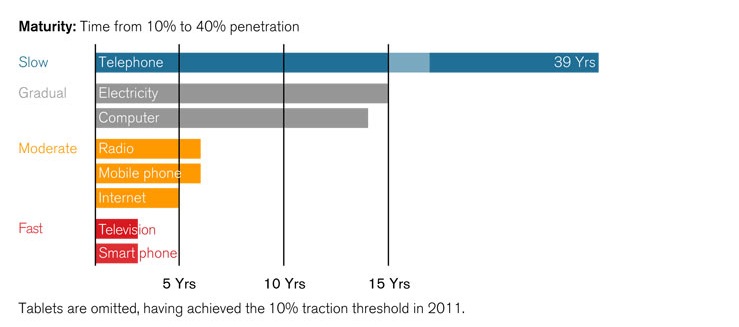An iconographic and text archive related to communication, technology and art.
This week in the link roundup: share your photos with a time limit, legal problems associated with the trial of mass murderers, traders want to harness neutrinos, scientist are inspired by iron ingesting microbes, the very fast diffusion of smart phone (some numbers) and an upcoming talk (at the MoMA) of artist, author, teacher and game designer Pippin Barr.
• • •
- Datavisualization.ch Selected Tools:
Datavisualization.ch Selected Tools is a collection of tools that we, the people behind Datavisualization.ch, work with on a daily basis and recommend warmly. This is not a list of everything out there, but instead a thoughtfully curated selection of our favourite tools that will make your life easier creating meaningful and beautiful data visualizations.
- The Atlantic: “Forget About It: Making the Internet More Like Our Brains” by Megan Garber, May 8, 2012. Excerpt:
Snapchat is an iPhone app that, fascinatingly and maybe even usefully, lets you apply a time limit to the photos you share with friends. You can decide whether your recipient (or a group of recipients) sees a photo for 2 seconds, or 5, or 10 … before what they see disappears entirely. Think Path, with a focus on photos. Think Instagram, with an expiration date.
- Digital Journal: “Op-Ed: Three current trials for mass murder worlds apart” by Alexander Baron, May 8, 2012. Excerpt:
The third criminal trial for mass murder is one that has received very little coverage in the mass media. It is, unusual, to say the least. For example, it is selling merchandise – fancy a badge or a T-shirt?
Click hereand follow the instructions.The Kuala Lumpur War Crimes Tribunal was founded by Mahathir bin Mohamad, who served as Prime Minister of Malaysia from 1981-2003. Dr Mahathir is admittedly a somewhat off-beat character for so senior a politician, but no one who leads a country for 22 years is to be treated with contempt. The purpose of the tribunal is to criminalise war,
which involves“holding perpetrators of war crimes to account for their actions especially when relevant international judicial organs fail to do so”. [November 7, 2012: the stroke links were flagged by Google for containing malware]The main argument is far fetched, to say the least, but it remains an interesting (and very quick) introduction to the legal problems surrounding the trial of mass murderers.
- Forbes: “Neutrinos to Give High-Frequency Traders the Millisecond Edge” by Bruce Dorminey, April 30, 2012. Excerpt:
Eighty some years after Wolfgang Pauli first postulated its existence, the lowly neutrino is now on the cusp of being harnessed to facilitate automated high-frequency trading through earth itself. That is, if this weakly-interacting, electrically-neutral subatomic particle can be successfully time-encoded and pointed from one financial center to another.
The idea is that by sending neutrino-based buy-and-sell messages via a 10,000 km shortcut through earth; high-velocity traders could handily beat their competitors.
- BBC: “Magnetic bacteria may help build future bio-computers” May 7, 2012. Excerpt:
A team from the UK’s University of Leeds and Japan’s Tokyo University of Agriculture and Technology have used microbes that eat iron.
As they ingest the iron, the microbes create tiny magnets inside themselves, similar to those in PC hard drives.
The research may lead to the creation of much faster hard drives, the team of scientists say.
See the original press release by Univeristy of Leeds: “Bacterial builders on site for computer construction” May 4, 2012.
- Technology Review: “Are Smart Phones Spreading Faster than Any Technology in Human History?” by Michael Degusta, May 9, 2012. Excerpt:
These figures show that smart phones, after a relatively fast start, have also outpaced nearly any comparable technology in the leap to mainstream use. It took landline telephones about 45 years to get from 5 percent to 50 percent penetration among U.S. households, and mobile phones took around seven years to reach a similar proportion of consumers. Smart phones have gone from 5 percent to 40 percent in about four years, despite a recession. In the comparison shown, the only technology that moved as quickly to the U.S. mainstream was television between 1950 and 1953.
It would be interesting to re-write this analysis using Everett Rogers’s well known theory of diffusion.
-
MoMA: “Contemporary Art Forum: Critical Play—The Game as an Art Form” Friday, May 18, 2012, 10:00 a.m.–5:00 p.m.
Pippin Barr whom I wrote about recently (Zorba: The Video Game) will be present at the MoMA to discuss with fellow artist Scott Snibble (designer of Björk’s Biophilia apps) and Paola Antonelli, Senior Curator at the MoMA for the Department of Architecture and Design. This MoMA’s “Contemporary Art Forum” is the second time in just a few weeks that video games are given a serious treatment by or inside a notable national museum (see the Smithsonian American Art Museum).
- By Philippe Theophanidis
- on
- ― Published in Link-roundup





